Kleve, best known as the home of Anne of Cleves, is a county town in the German state of Northrhine-Westphalia, just 10 kilometres from the Dutch border, with a population of just under 50,000 – and an interesting collection of statues.
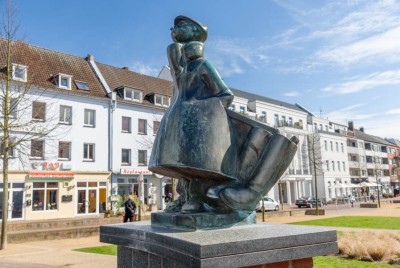
Officially called ’The Little Cobbler of Kleve’ (Klever Schüsterken), everyone calls this the Spitting Statue (Spuckmänneken) – for obvious reasons when the fountain is turned on. After the notorious Netherlands-West Germany 1990 World Cup quarter-final, local wags bedecked it in a Frank Rijkaard Dutch national team jersey! Again, officially, this 1951 statue by Joseph Brüx commemorates Kleve’s shoe industry – the city was long Germany’s capital of children’s shoes.
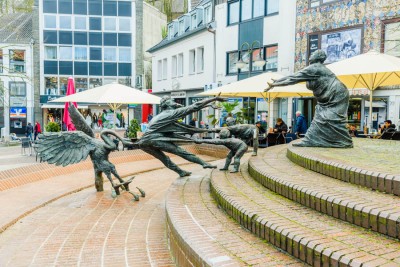 Made by Karl-Henning Seemann in 1984-6, the Lohengrin Fountain statue in the heart of Kleve’s pedestrian precinct – informally called the Elsa Fountain – tells the story of Kleve’s mythical founder as related by Wagner.
Made by Karl-Henning Seemann in 1984-6, the Lohengrin Fountain statue in the heart of Kleve’s pedestrian precinct – informally called the Elsa Fountain – tells the story of Kleve’s mythical founder as related by Wagner.
Princess Beatrix lived in the Swan Castle just above the fountain around a thousand years ago. During a walk along the Rhine. she was approached by a Swan who wore a gold chain around its neck, pulling a boat on which a Knight stood, who told her he had come to defend her country. Beatrice fell in love with him and wanted to marry him. He said “yes” under one condition: that she never ask about his name or origin. The couple was happy and had three sons who, over time, became curious and tried to find out where their father came from. Eventually, Beatrix asked forbidden question to her Swan Knight. With a sad face he replied, “My name is Elias and I come from the earthly paradise”. Immediately the Swan appeared and then vanished with the Knight. Beatrice died a few months later of a broken heart.
The statue shows the Swan Knight’s sons desperately trying to stop him from being taken away, as Beatrice looks on helplessly.
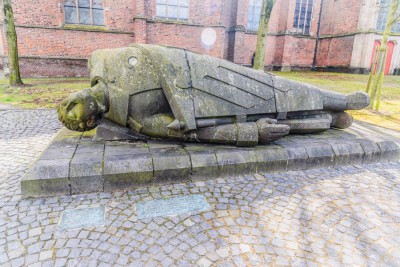
Right beside the Collegiate Church in Kleve, the Dead Warrior (Toter Krieger) statue by Ewald Mataré was erected as part of a World War One memorial originally in 1932. In 1938, it was removed and buried by the Nazis as so-called ‘degenerate art’: although perhaps in reality it was rather too honest an artistic statement about the consequences of industrialised total war for people who were about to start another one. In 1977, parts of the figure were accidentally discovered and it was restored and re-erected as a “warning against injustice and violence” in 1981. The biblical quote on the ground beside it is an extract from the First Letter of Peter – “Those who desire life avoid evil and do good: they seek peace and pursue it”.
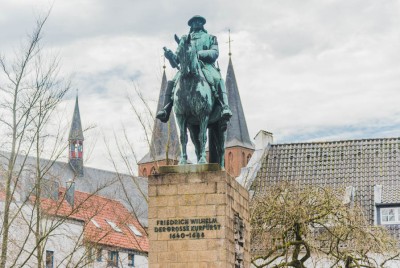 Memorial to the Great Elector, Friedrich Wilhelm of Brandenburg, framed by the twin spire of the Collegiate Church in Kleve. By Peter Breuer, and erected in 1909 for the 300th anniversary of the incorporation of the Dutchy of Kleve into the Kingdom of Brandenburg-Prussia. Friedrich Wilhelm spent the first six years of his forty-eight year reign (beginning 1640) ruling from Kleve. The monument was damaged in 1945 and replaced in 1974.
Memorial to the Great Elector, Friedrich Wilhelm of Brandenburg, framed by the twin spire of the Collegiate Church in Kleve. By Peter Breuer, and erected in 1909 for the 300th anniversary of the incorporation of the Dutchy of Kleve into the Kingdom of Brandenburg-Prussia. Friedrich Wilhelm spent the first six years of his forty-eight year reign (beginning 1640) ruling from Kleve. The monument was damaged in 1945 and replaced in 1974.
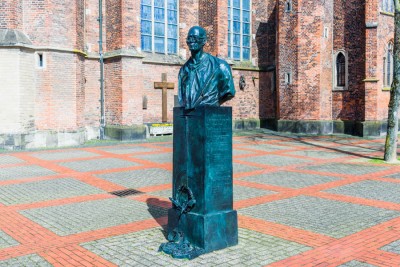 Statue of Karl Leisner, one of Kleve’s most celebrated sons. During his diaconal year, he contracted tuberculosis, and while recovering at a spa in the Black Foresst, he was overheard by a fellow patient criticising Adolf Hitler, which he refused to deny under Gestapo interrogation. He was imprisoned, and eventually transferred to the Priests’ Barracks in Dachau in 1941. There he was clandestinely ordained a priest in 1944, was liberated in March 1945 but very weak died just five months later in a sanitorium, aged just 30.
Statue of Karl Leisner, one of Kleve’s most celebrated sons. During his diaconal year, he contracted tuberculosis, and while recovering at a spa in the Black Foresst, he was overheard by a fellow patient criticising Adolf Hitler, which he refused to deny under Gestapo interrogation. He was imprisoned, and eventually transferred to the Priests’ Barracks in Dachau in 1941. There he was clandestinely ordained a priest in 1944, was liberated in March 1945 but very weak died just five months later in a sanitorium, aged just 30.
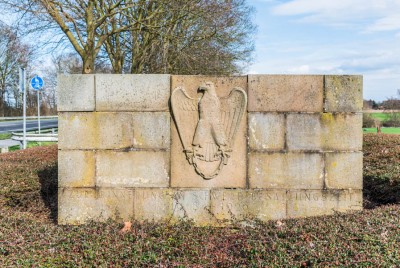 Despite sitting next to the main Kleve-Emmerich road, this memorial was overgrown and invisible for decades until 1990 when a local heritage society revealed and restored it. It commemorates a little known byway of history – the Belgian Occupation of the Lower Rhine from 1918 to 1926: “the difficult time of occupation” (schwehre Besatzungszeit).
Despite sitting next to the main Kleve-Emmerich road, this memorial was overgrown and invisible for decades until 1990 when a local heritage society revealed and restored it. It commemorates a little known byway of history – the Belgian Occupation of the Lower Rhine from 1918 to 1926: “the difficult time of occupation” (schwehre Besatzungszeit).
This was part of the much larger and better known allied occupation of the Rhineland after World War One, largely carried out by France. The Belgians had their reasons for being bitter about what the Germans had done in their country during the war and this evidently was not a happy time.
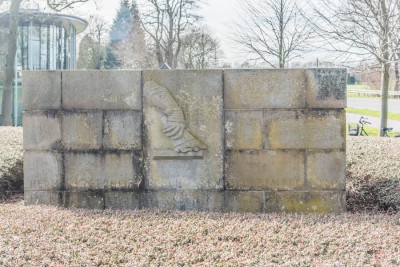 There are two people commemorated by name: Hermann Vingerhoet, shot on New Years’ Eve 1946 on his farmhouse on this site; and Wilhelm Kempes, shot in the same year in the village of Asperden, about 15 km away.
There are two people commemorated by name: Hermann Vingerhoet, shot on New Years’ Eve 1946 on his farmhouse on this site; and Wilhelm Kempes, shot in the same year in the village of Asperden, about 15 km away.
Part of the reason that the memorial may have been forgotten was that it was designed by Arno Breker, who was later made “official state sculptor” by Hitler. Needless to say, he remains a disliked figure today.
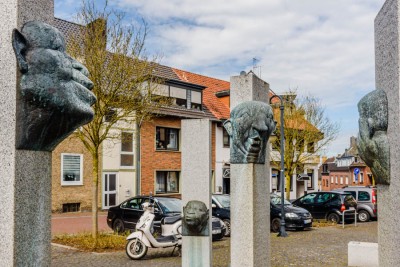 The Fools’ Fountain (Narrenbrunnen) in Kleve by the Collegiate Church. By Annette Mürdter and erected 2001. The bronze, water-spouting heads recall the once-present ‘head’ of society, the king, and six councilors.
The Fools’ Fountain (Narrenbrunnen) in Kleve by the Collegiate Church. By Annette Mürdter and erected 2001. The bronze, water-spouting heads recall the once-present ‘head’ of society, the king, and six councilors.





